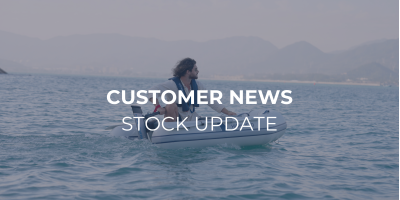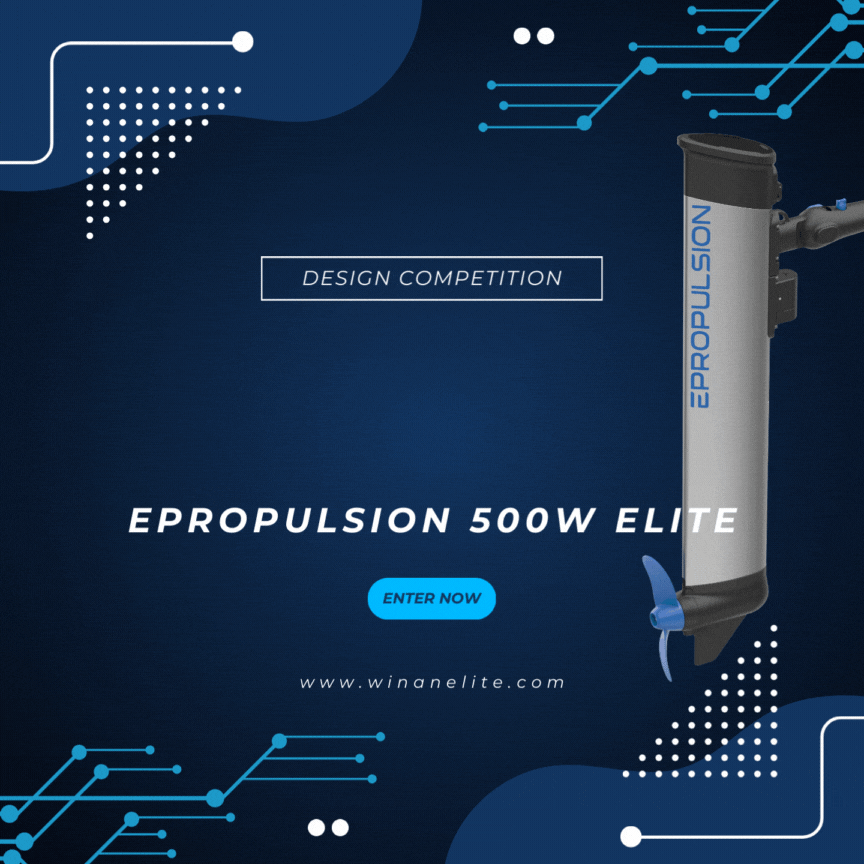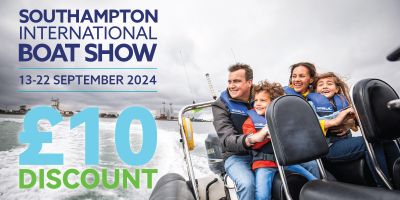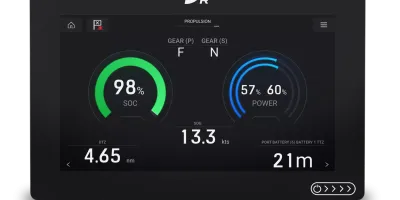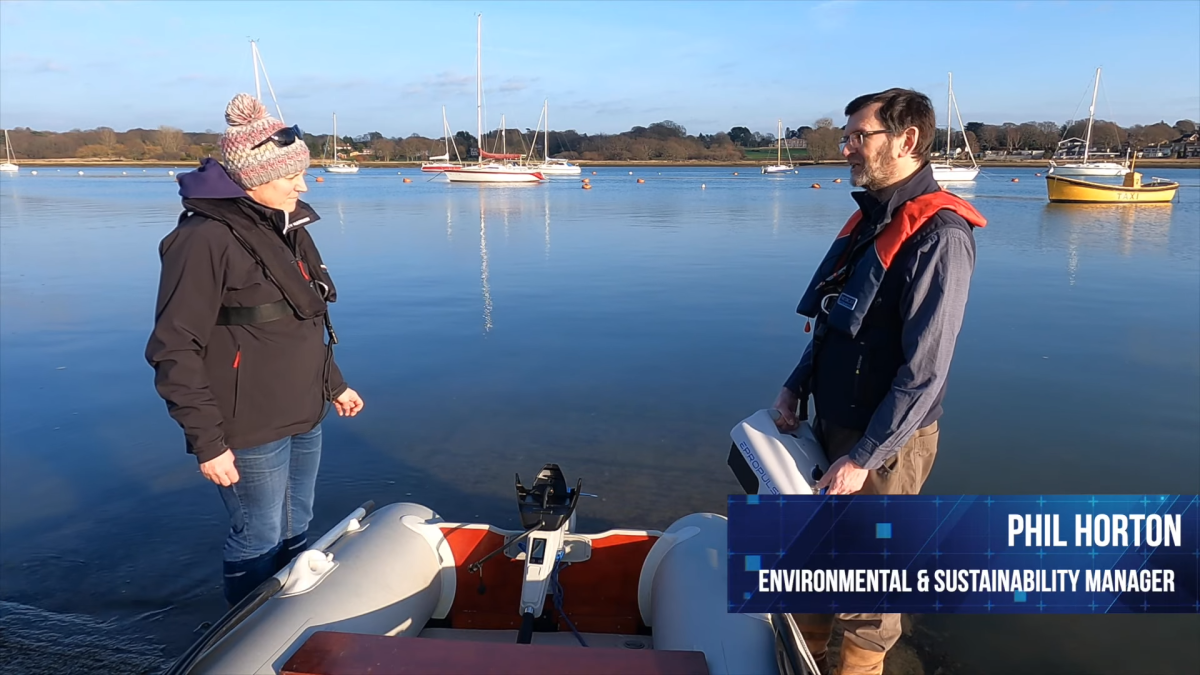
Electric outboards for training centres and sailing clubs
Are electric motors suitable for RYA training centres?
Using electric outboards for watersports training centres and club safety boats are now a realistic option. The technology and batteries have rapidly developed so that, as with electric cars, ‘range anxiety’ is a thing of the past. Rachel Andrew’s, the RYA’s Chief Instructor for Power Schemes and Phil Horton, RYA Sustainability Manager, tested an ePropulsion Spirit 1.0 electric outboard.
Why switch to electric outboards for training or coaching?
In the video below Rachel and Phil quickly conclude some of the benefits electric power can offer RYA Instructors. “I can’t believe how quiet this is,” says Rachel. “You can barely hear it!” She goes on to explain that it’s much easier for Sailing Instructors to speak over an electric outboard that is nearly silent. Normally, a petrol outboard must be turned off to hear. Instead, now the trainees can hear the instruction – first time. Phil and Rachel also discuss how:
- the electric drive is very efficient, especially at slow speeds – compared to many traditional outboards
- in neutral no power is consumed – so there’s no wastage
- the motors high torque allows excellent boat handling, turning and manoeuvrability
Advantages of electric motors for training centres
An instant advantage of an electric safety boat or club launch is that starting the motor is totally reliable. It’s a simple press of a button to start, even if the boat has been sat unused on a mooring for a while. No outboard cords to pull either. There’s a variety of practical benefits for RYA Training Centres and Sailing Clubs to switch to electric powered outboards or motors. Perhaps not immediately obvious, there are costs savings to be considered too:
- no need to purchase expensive fuel
- special facilities for safe fuel storage are no longer needed
- no need for safety boat drivers to carry fuel tanks to the dock
- boats do not require refueling or taking to a fuel berth
- no risk of fuel spillage into the water or boat
Lower running costs for Clubs and RYA Training Centres
The electric outboards have a direct drive between the throttle and propeller. So there are few moving parts and no cables. As a result there are few maintenance costs as the motors do not need servicing or winterising. They simply need an occasional rinse, a spray of WD40 on the connectors and the anode checking annually. Although the unit cost of the outboard is higher than a petrol outboard, overtime the low running costs mean the outboards start to pay for themselves. Phil Horton has calculated that charging up the Spirit 1.0 Plus outboard’s 1kW battery uses a charging efficiency of around 1.5 kW hours. And using current electricity prices this costs around £0.30, giving around 5 hours motoring using half throttle speed.
Managing electric motor batteries vs fuel tanks
After use, there’s no need to lug fuel cans around or risk of spillage when refueling. The electric batteries can be simply plugged in to recharge. That is just like a handheld VHF radio would be recharged.  The batteries can be charged up at any time. They do not have to be fully discharged before plugging in. And there’s no need to do fuel mixes or have a separate fuel store. Since many Clubs and Centres rely on volunteers, this keeps things simple and enables multiple people to manage the boats. The ePropulsion Spirit outboards and larger, long-range Navy outboards can be set up to recharge whilst they are discharging power. For example, a solar panel can charge the battery whilst the outboard is running. Rachel observes that for larger electric set ups, the separate batteries might be heavier and harder to lift off a boat. Especially if they have been built into a locker in a safety boat such as a Rigiflex, this may be awkward. However, it simply means a slight change in set up at the Training Centre, sailing or watersports club. Running a standard 240 volt powerline down to the berthing dock or boat park makes it easy to plug in the boat batteries after use. And the batteries are pretty fast to recharge too, taking around 2 to 7 hours depending on numbers of chargers used and size of battery.
The batteries can be charged up at any time. They do not have to be fully discharged before plugging in. And there’s no need to do fuel mixes or have a separate fuel store. Since many Clubs and Centres rely on volunteers, this keeps things simple and enables multiple people to manage the boats. The ePropulsion Spirit outboards and larger, long-range Navy outboards can be set up to recharge whilst they are discharging power. For example, a solar panel can charge the battery whilst the outboard is running. Rachel observes that for larger electric set ups, the separate batteries might be heavier and harder to lift off a boat. Especially if they have been built into a locker in a safety boat such as a Rigiflex, this may be awkward. However, it simply means a slight change in set up at the Training Centre, sailing or watersports club. Running a standard 240 volt powerline down to the berthing dock or boat park makes it easy to plug in the boat batteries after use. And the batteries are pretty fast to recharge too, taking around 2 to 7 hours depending on numbers of chargers used and size of battery.
Maximise electric outboard range - using wind and tides
During the Spirit electric outboard test Rachel and Phil talk about power consumption. The tiller display screen gives a constant read out of power usage, showing remaining hours and watts in use. Phil explains that as you accelerate or decelerate the range and hours will go down or up accordingly. For example:
- up river with not much tidal flow he was using 150 watts which the display screen showed will last about 7 hours.
- further down the river he was using 500 watts right in the main tidal stream. By simply moving into the side of the river in shallow water he could throttle back. This dropped battery usage to 200 watts to hold same speed and increase run times.
The power requirement goes up as throttle speed increases, as does fuel consumption when speeding around with a petrol outboard. The team discuss how switching to electric motors mean a more traditional approach to motoring. Being aware of and using the wind and tides to your advantage, rather than pushing against them, helps conserve power and range. Such as getting out of the main tidal stream and into shallower water. As Rachel says, “It’s exactly what the RYA teach – doing things properly!” Phil Horton also advises always choosing Lithium Ion Phosphate batteries, rather than cheaper models. They have much better chemistry and energy density so are more effective. They are much safer and the good ones, like ePropulsion’s, have excellent management systems to protect the battery from over-discharging.
Key decisions for using electric motors for training centres
The key advice when choosing electric outboards for training centres is to work out how the boat will be used. Also, the operating waters where the on water training normally takes place. A safety boat fleet normally requires a mix of boats and not just fast ‘chase’ boats. The smaller electric motors are ideal to use with novices or juniors. For example, kayaking or sailing inshore, on rivers or lakes or situations where there is no requirement to chase around a long course. These smaller units have a removable battery, which is easy for clubs to manage, store and recharge. Larger boats doing different duties require more power and therefore larger batteries. Strong tides or currents will likely require more power so a larger, long-range electric outboard would be more suitable. This also means thinking about charging options, such as bringing safety boats alongside a pontoon. Many ‘club’ committee boats or launches often are used to motors out to a start line and back. These are ideal for conversion to electric motors. If fitted with solar panel, a trickle charge will keep the batteries topped up whilst the boat is not being used.
What type of electric motor is suitable for a safety boat fleet?
Spirit Electric Outboard These portable outboards are ideal for smaller safety boats and can driven by a tiller or via a remote controller. The battery separates from the outboard making it easier to carry. Or it can be fitted with a separate more powerful onboard battery unit and throttle control. Navy Electric outboard These are long-range, powerful outboards can push much larger boats. They can be fitted with one or more E-Series batteries, that run in parallel, for longer distances and range. 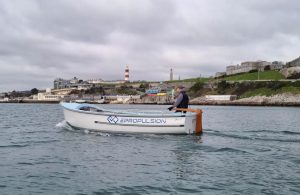 POD Drives The POD drives are a neat solution where the integrated motor and propeller are fitted externally. Powered by the E-Series batteries, they are ideal for heavier displacement launches such as the Plymouth Pilot and Nelson 18’s. I-Series Inboard These ePropulsion Inboard electric motors have no moving parts and can be retro-fitted to a prop shaft. Ideal for a larger committee boat. Discover more on the RYA website.
POD Drives The POD drives are a neat solution where the integrated motor and propeller are fitted externally. Powered by the E-Series batteries, they are ideal for heavier displacement launches such as the Plymouth Pilot and Nelson 18’s. I-Series Inboard These ePropulsion Inboard electric motors have no moving parts and can be retro-fitted to a prop shaft. Ideal for a larger committee boat. Discover more on the RYA website.

